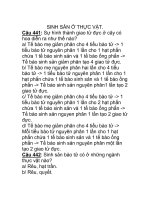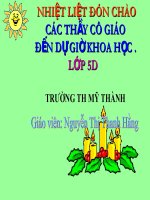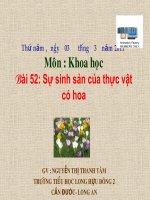Sinh san o thuc vat
Bạn đang xem bản rút gọn của tài liệu. Xem và tải ngay bản đầy đủ của tài liệu tại đây (139.49 KB, 12 trang )
Activity: Learn about the flowers and parts of a flower
Teacher activities
Student activities
- Teacher asks student to observe the
- Student observe and write down the
flowers that student brought to class and result:
discuss in group:
+ Talk about the color of the flowers?
+ Flowers have many different colors:
white, blue, pink, red, purple ...
+ In the flowers, which flowers do not
Each flower has a different aroma
smell?
- Teacher asks representative of the
- Representing each group to present
group to present the result
result
- Teacher asks student to choose any
- 2-3 student indicate the part of flower
flower and indicate where peduncle,
petals, stamens.
- Teacher commentes
- Student track
- Teacher concludes:
- Student listen
Flowers vary in shape, color and aroma.
Each flower usually has peduncle, bell
petals and stamens.
PLANTS (Reproduction)
Xung quanh chúng ta có rất nhiều cây. Chúng có hình dạng và độ lớn khác nhau. Mỗi
cây gồm bộ phận nào?
Mỗi cây thường có các bộ phận : rễ, thân, lá, hoa, quả và hạt
Tìm hiểu sinh sản ở thực vật (Reproduction)
Từ một cây đậu xanh, làm thế nào để tạo được nhiều cây đậu con?
Từ một cây đậu xanh, để tạo được nhiều cây đậu con thì đợi cho cây đậu ra hoa
kết quả, đến khi quả chín lấy hạt bên trong đem gieo sẽ cho nhiều cây đậu con.
Ngoài cách sinh sản như cây đậu trên thì có hình thức sinh sản khác nữa. Đó là : sinh
sản bằng thân, bằng cành hay cịn gọi là sinh sản vơ tính. Ví dụ: thân rau muống,
thân cây mía, cành giâm bụt,…
A.HÌNH THỨC SINH SẢN VƠ TÍNH (ASEXUAL REPRODUCTION)
* Cơ quan sinh dưỡng và khái niệm sinh sản vơ tính
Vậy chúng ta tìm hiểu xem cây con mọc lên từ bộ phận nào của cây mẹ ? Để hiểu rõ
hơn chúng ta cùng nhau hoàn thành bảng sau:
ST
T
Tên cây
Sự tạo thành cây mới
Mọc từ phần nào
của cây ?
1
2
3
4
Rau má
Thân bò
Gừng
Thân rễ
Khoai lang
Rễ củ
Thuốc bỏng
Lá
Phần đó thuộc
Trong điều kiện
loại cơ quan nào?
nào ?
Cơ quan sinh
Đất ẩm
dưỡng
Cơ quan sinh
Đất ẩm
dưỡng
Cơ quan sinh
Đất ẩm
dưỡng
Cơ quan sinh
Nơi ẩm
dưỡng
Như vậy, cây con có thể mọc lên từ thân, rễ, hoặc lá từ chính cây mẹ mà khơng
cần kết hợp với cây khác. Đó là sinh sản vơ tính. Là hình thức mà cây con có thể mọc
lên từ một bộ phận của cây mẹ,
Và các bộ phận của cây : thân, rễ, lá người ta gọi là cơ quan sinh dưỡng của cây.
* Đặc điểm của sinh sản vơ tính ở thực vật
Do đó, chúng ta nhận ra đặc điểm của sinh sản vơ tính ở thực vật
Cơ thể con giống với cơ thể mẹ
Đời con thích nghi với mơi trường sống là nơi có đất ẩm
* Ứng dụng của sinh sản vơ tính ở thực vật
Có 3 hình thức
+ Chiết cành: làm cho cành ra rễ ngay trên cây mới rồi mới cắt đem trồng thành cây
mới
+ Giâm cành: cắt 1 đoạn cành có đủ mắt, chồi đem cắm xuống đất ẩm cho cành đó bén
rễ, phát triển thành cây mới
+ Ghép mắt: là đem bộ phận sinh dưỡng của cây đó là mắt ghép. Chồi ghép của cây này
gắn vào cây khác (gốc ghép) cho cây tiếp tục phát triển.
B.HÌNH THỨC SINH SẢN HỮU TÍNH (SEXUAL REPRODUCTION)
Sinh sản có hiện tượng thụ tinh gọi là sinh sản hữu tính
Gồm 2 dạng :
- Sự sinh sản ở thực vật có hoa
- Cây con mọc lên từ hạt
* Sự sinh sản ở thực vật có hoa
Cơ quan sinh sản:
+ Hoa là cơ quan sinh sản cả những lồi thực vật có hoa. Cơ quan sinh dục đực gọi là
nhị. Cơ quan sinh dục cái gọi là nhụy
+ Một số cây có hoa đực riêng, hoa cái riêng. Ở đa số cây khác, trên cùng một hoa có cả
nhị và nhụy.
Q trình sinh sản :
1. Thụ phấn
Là hiện tượng đầu nhụy nhận được những hạt phấn của nhị. Có 2 hình thức:
+ Tự thụ phấn là hạt phấn rơi vào đầu nhụy của chính hoa đó.
+ Giao phấn là hạt phấn của hoa này chuyển đến đầu nhụy của hoa khác trong cùng 1
cây hoặc giữa các cây khác nhau
Các lồi hoa thụ phấn nhờ gió hoặc cơn trùng:
+ Đặc điểm của lồi hoa thụ phấn nhờ cơn trùng: thường có màu sắc sặc sỡ hoặc hương
thơm hấp dẫn côn trùng (VD: phượng, bưởi, cam, chanh, mướp, bí, bầu,…)
+ Đặc điểm của lồi hoa thụ phấn nhờ gió: khơng có màu sắc đẹp, cánh hoa, đài hoa
thường nhỏ hoặc khơng có (cây ngơ, cây lúa,…)
2. Thụ tinh
+ Sau khi thụ phấn, từ hạt phấn mọc ra ống phấn
+ Ống phấn đâm qua đầu nhụy, mọc dài đến noãn
+ Tại noãn tế bào sinh dục đực kết hợp với tế bào sinh dục cái tạo thành hợp tử. Hiện
tượng đó gọi là hiện tượng thụ tinh
3. Kết hạt và tạo quả
+ Sau khi thụ tinh, hợp tử phát triển thành phơi
+ Nỗn phát triển thành hạt chứa phơi
+ Bầu phát triển thành quả chứa hạt
Các giai đoạn sinh sản: hạt phấn thụ tinh với noãn tạo thành hợp tử phôi hạt
hạt nảy mầm cây con cây trưởng thành có hoa hạt phấn nỗn
* Cây con mọc lên từ hạt
Ngồi ra, có nhiều cây mọc lên từ hạt (hạt đậu xanh, đậu đen,…) nhưng bạn có biết nhờ
đâu mà hạt mọc ra thành cây không?
Cấu tạo hạt :
Hạt gồm : vỏ, phôi và chất dinh dưỡng
+ Ngoài cùng là vỏ hạt
+ Phần hai bên là chất dinh dưỡng của hạt
+ Phần màu trắng đục nhỏ phía trên đỉnh ở giữa khi ta tách ta làm đơi đó là phơi
Điều kiện để hạt nảy mầm :
Là có độ ẩm và nhiệt độ thích hợp (khơng q nóng hoặc khơng q lạnh)
Q trình phát triển của cây thành hạt :
VD: Sự phát triển của cây mướp từ khi gieo hạt đến khi mọc thành cây ra hoa kết quả
+ Hạt mướp chuẩn bị gieo
+ Sau vài ngày, rễ mầm mọc nhiều. Hai lá mầm xòe ra, thân mầm nhú lên khỏi mặt đất
+ Hai lá mầm chưa rụng, cây đâm chồi, mọc thêm lá mới
+ Mướp ra hoa kết quả
+ Quả mướp già không ăn được. Xẻ đôi quả mướp thấy trong ruột có nhiều hạt
+ Bóc lớp xơ mướp ta được nhiều hạt màu nâu bóng, có thể đem gieo trồng
* Ưu điểm của hình thức sinh sản hữu tính:
+ Tăng khả năng thích nghi của thế hệ con đối với môi trường sống luôn thay đổi
+ Tạo sự đa dạng về di truyền, tạo ra nhiều cá thể khác nhau với bố mẹ
SO SÁNH 2 HÌNH THỨC SINH SẢN Ở THỰC VẬT
Khái
niệm
Hính
thức
Giống
mới
Ưu/
Nhược
điểm
Sinh sản vơ tính
Là hình thức sinh sản khơng có sự
kết hợp của giao tử đực và giao tử
cái
Sinh sản hữu tính
Là hình thức sinh sản có sự kết
hợp giữa giao tử đực và giao tử
cái
Cơ thể mới được hình thành từ 1
phần của cơ thể mẹ
Con được hình thành do cớ sự
kết hợp giữa bố và mẹ
Giống hệt mẹ
Giống cả bố và mẹ
Con thích nghi kém
Con thích nghi với mơi trường
sống ln thay đổi
English
There are many trees around us. They have different shapes and sizes. Which
parts of the tree are included?
Each plant has parts: root, stem, leaves, flower, fruit and seed
From a green bean plant, how to make more bean plans?
From a green bean plant, to produce a lot of bean plants, wait for the bean to
produce the flower to fruit, until the fruit ripens. Then, the seeds is inside the fruit and
sowed and it will give more bean plant. In addition to reproduction as the bean plant,
there is another form of reproduction. It is reproduction by the steam, with branch or
also called asexual reproduction. For example: vegetable stalks, sugarcane stalks, cut
branches, ...
A. ASEXUAL REPRODUCTION
* Vegetative organ and define
The seedlings grow from which part of the mother plant? To understand better we
complete the following table:
No
Tree name
Produce of the seedings
Grow from which
What type of
Under what
part of the tree?
organ is that?
conditions?
1
Cucumber
Steam
Vegetative organ
Moist soil
2
Ginger
Steam
Vegetative organ
Moist soil
3
Potatoes
Root
Vegetative organ
Moist soil
4
Burn Tree
Leaf
Vegetative organ
Moist soil
Thus, seedlings can grow from the stem, roots, or leaves from the mother plant
itself, without the need to combine with other plants. It is asexual reproduction. The
form in which the seedlings can grow from a part of the mother plant.
And parts of the plant: the stem, the root, the leaf are called the vegetative organ
of the plant
General characteristics of the vegetative reproduction: the formation of new
plants from the vegetative organ of plants in condition of moist soil.
* Characteristics of asexual reproduction in plants:
So, we realize characteristics of asexual reproduction in plants:
• The new tree is the same as the mother tree
• Adaptive life is a place where there is moisture
* Application of asexual reproduction in plants
There are 3 forms :
+ Branches: make the branch to creat root on the new trees and then cut it to plant other
tree.
+ Cuttings: cut a segment of branch with enough eyes, shoots and then plant it in
condition of moisture soil to the branch that make root and develop into a new tree.
+ Mutual eye: bring the vegetative part of the plant is the eye. The shoot of this plant
are attached to other plants (rootstock) for the plant to continue to grow.
B. SEXUAL REPRODUCTION
Fertilization in reproduction is called sexual reproduction
There are two types:
- Reproduction in flowering plants
- Seedlings grow from seeds
* Reproductuon in flowering phants
• Reproductive organs:
+ Flowers are the reproductive organs of the flowering plants. Male genital organ is
called stamen. Female genital organ is called the stigma.
+ Some plants have male flowers or female flowers. In most other plants, the same
flower has both stamen and stigma.
• Reproduction:
1. Pollination
It is the phenomenon that the head stigma receive pollen of the stamen.
There are 2 forms:
+ Self-pollinating : the pollen falls into the head of the flower itself.
+ Cross-pollination : the pollen of this flower moves to the head stigma of another
flower in the same tree or between different plants
Flowers is pollinated by wind or insects:
+ Characteristics of flowers is pollinated by insects: They are often colorful or fragrant
with attractive insects (Eg: phoenix, grapefruit, oranges, lemons, melons, squash,
gourds ...)
+ Characteristics of flowers is pollinated by wind: no beautiful colors, petals, petals are
small or no ( Eg: maize, rice, ...)
2. Fertilization
+ After pollinating, the pollen grows the pollen tube
+ The pollen tube stabs through stigma and then growing to the ovule.
+ At ovule, male genital cells together with female genital cells to form zygote. That
phenomenon is called fertilization
3. Seed and fruit
+ After fertilization, the zygote develops into embryo
+ The ovule inclues embryo that develops into seeds
+ The ovary include seeds that develop into fruits
Reproductive stages: the pollen fertilizes with the ovule to form zygote embryo
seeds seeds sprout seedlings mature plant with flowers pollen seeds
* Seedlings grow from seeds
In addition, there are many trees growing from seeds (green beans, black beans, ...) but
you know why the seeds grow into trees?
• The structure of the seed:
Each seed include: shells, embryos and nutrients
+ Beyond the shell
+ The second part is the nutrient of the seed
+ The small white opaque part at the top of the middle when we split it in two is the
embryo
• The conditions for seeds to germinate:
It has the appropriate humidity and temperature (not too hot or too cold)
• The development of seedlings:
VD: The development of the melon tree from sowing to maturation
+ The seeds are prepared to sow
+ After a few days, the roots grow much. Two leaves sprout, the buds sprout from the
ground
+ Two leaves haven’t fallen yet, the tree sprouts and grows new leaves
+ The tree grows flowers and produce fruits
+ The old fruit are not edible. Cut the fruit in the gut with seeds
+ Take more brown seeds and we can plant it
* Advantages of sexual reproduction:
+ Increasing the adaptability of the offspring to ever-changing habitats
+ Creating genetic diversity, create many different individuals with parents
COMPARISON 2 REPRODUCTIVE FORMS IN PLANTS
Asexual reproduction
The reproductive form without the
combination of male and female
gametes
Sexual reproduction
The reproductive form is a
combination of male gametes
and female gametes.
The new
tree
It is formed from one part of the tree.
It is formed by the combination
of father and mother.
New Breed
Identify the mother plant
Identidy both the mother plant
and the father plant
Adapt to
living
environmen
t
Weak
Good
Definition
NEW WORDS
- reproduction (n) : sự sinh sản, quá trình sinh sản
- root (n) rễ
- steam (n) thân
- branch (n) cành
- leaf (n) lá
- flower (n) hoa
- fruit (n) quả
- seed (n) hạt
- shoot (n) chồi
- seedling (n) sự tạo mầm, cây con (cây giống)
- asexual reproduction (n) sinh sản vơ tính
- vegetation organ (n) cơ quan sinh dưỡng
- vegetation reproduction (n) sinh sản sinh dưỡng
- moist soil (n) đất ấm
- sexual reproduction (n) sinh sản hữu tính
- fertilization (n) sự thụ tinh
- reproduction organ (n) cơ quan sinh sản
- male genital organ (n) cơ quan sinh dục đực
- female genital organ (n) cơ quan sinh dục cái
- stamen (n) nhị hoa
- stigma (n) nhụy hoa
- pollination (un) sự thụ phấn
- to pollinate : thụ phấn
- pollen (n) hạt phấn
- pollen tube (n) ống phấn
- to stab : đâm
- ovule (n) noãn
- male genital cell (n) tế bào sinh dục đực
- female genital cell (n) tế bào sinh dục cái
- zygote (n) hợp tử
- embryo (n) phôi
- ovary (n) bầu nhụy, buồng trứng
- to germinate : nảy mầm
- shell (n) vỏ (the hard outer part of eggs, nuts, some seeds and some animals)
- nutrient (n) chất dinh dưỡng (a substance that is needed to keep a living thing alive
and to help it to grow)
- humidity (un) độ ẩm (the amount of water in the air)
- to sow : gieo hạt (to plant or spread seeds in or on the ground)
- to sprout : nảy mầm, đâm chồi ((of plants or seeds) to produce new leaves or buds; to
start to grow)
- bud (n) chồi, nụ to be in bud: đang ra nụ, đang ra lộc (cây hoa)
- to be edible (a) : không thể ăn (fit or suitable to be eaten; not poisonous)
- gut (n) ruột (ở động vật)









